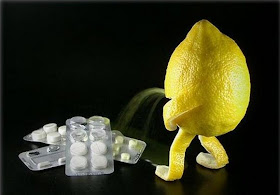 |
| Lemon (lat. Citrus x limon) |
Lemon (lat. Citrus limon x) is a tree of the genus Citrus (family Rutaceae) and it's a fruit. The result isancient crossroads presumably pomelo and citron, but thrives for centuries as an independent tree is propagated by cuttings or grafting. Lemon is a foodstuff with probably the longest list of positive effects on our health.
Lemons are grown all over the world in countless variations, apparently, more or botanists do not register. The differences between the new variations are only in appearance, and their nutritional properties and economic importance, remain unchanged. The lemon is very rarely used as fresh fruit, so that small changes in flavors are not too important. For industrial use is good any variation except, perhaps, those who are not permanent enough, and must be used very soon after harvesting to take advantage. Such as, for example, almost unknown variations of red and sweet lemon fruit whose sour though, but that is also sweet, so growers use them as fresh fruit. Their fruit when harvested, it must be consumed in two or three days, so it is almost unknown.
Lemon is mainly divided into yellow and green, but it's just a commercial division, they grow on the same tree. Lime develops from spring blossom tree artificial, deliberately induced drought that has to last for forty days. Thus obtained spring fruit has a thin, green bark and very juicy "meat". Such fruit shall long travel and storage and the possible export all over the world. The usual yellow fruits, which are common in the market, the growth of the same tree, only ripen in winter. This way of using wood significantly shortens lifespan, but it is very cost effective and is very often used.
 |
| Lemon (lat. Citrus x limon) |
The appropriate climate citrus trees bore twice a year. Spring flowering of fruit which grow very best takes at least two months. Just so long ripe fruit picking can wait at the border, which allows continuous harvesting all winter. One lemon has about 57% edible substance, accounts for 40% bark and seeds to about 3%. Of course, we must take into account that these are average values and different varieties may vary significantly from these. The result is that the lemon is used not only to obtain juice and citric acid. The bark is candied fruit and get essences and pectin. From seed to produce oil, and the rest is processed for animal feed. One mature tree in good weather conditions, giving 600 to 800 fruits per year.
 |
| Lemon (lat. Citrus x limon) |
 |
| Lemon (lat. Citrus x limon) |
Lemon fruit contains 40 to 50% juice. Juice color is yellow to pale green, and tart flavor. Up to 8% citric acid, small amounts of other organic acids, 3% sugar and lots of vitamins, especially vitamin C. Before use it is pasteurized or concentrated. Pasteurized juice is free of preservatives and lasting at least one year, is used as a food and drinks. The concentrated juice is commonly used for the industrial processing of meals and drinks.
Lemon essential oil is a yellow liquid with a strong odor of lemon, and is completely soluble in alcohol. It consists predominantly (about 90%) of limunina . Refined oil is used primarily in the food industry (liqueurs, cakes) and for making perfume. Industrial cleaners and detergents used oil and diluted with cheaper products, such as paraffin oil.
Long before modern farmacy was the lemon used as medicine. When we still did not know for how many vitamins and health benefits, lemon has been used as a medicine. First of all, it is considered an effective tool against bleeding open wounds and for cleaning wounds with pus. Lemon is indispensable in the treatment of scurvy they knew more ancient seafarers who have to travel far each taking with them large supplies of lemons. In Sicily, which had a lot of problems with the supply of drinking water, in all water supplies was putting fresh lemon halves. People have known from experience that lemon disinfects water, and modern science has confirmed it. Perhaps from the ancient practice habits that arises today serve water with lemon flap.
 |
| Lemon (lat. Citrus x limon) |
Lemon significantly elevates the immune system, it is a natural antibiotic that protects against bacteria and viruses. Its acidity rejects harmful bacteria but, interestingly, it attracts bacteria useful for our digestive system. Most diets recommend a lemon because it gives a feeling of satiety while rising energy tired body. Slight effect on the liver, digestion and the blood test because it lowers cholesterol. At high cholesterol recommended a combination of lemon and garlic on which we will soon write. Lemon is also an effective treatment for heartburn. Citrus usually not wise to consume with heartburn, but if you mix a tablespoon of lemon and half a cup of water to drink and heartburn will disappear. Apparently lemon helps with menstrual pain.
Intake of 100 g of lemon covered by 71% of daily requirement of vitamin C for adults and 7% of daily requirement of potassium, calcium 1% and 9% magnesium. Lemons vary in sweetness, and the rule is that the sweeter lemons richer in minerals and vitamins. How to know that a lemon sweet? The first rule is to choose yellow lemons before green. The second rule is to choose heavy lemons. Lemon-rich useful substances has a thin crust and a rich interior and heavier than the same size lemon with a thick rind and not so rich in beneficial ingredients. Depending on your weight of one to two lemons a day are optimal.
 |
| Lemon (lat. Citrus x limon) |